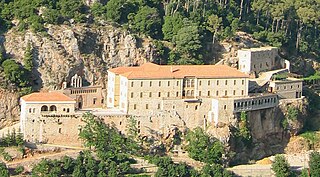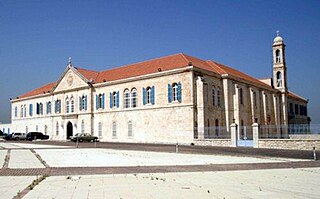Basilian may refer to a number of groups who are followers of Saint Basil the Great and specifically to:

Basilian monks are Greek Catholic monks who follow the rule of Basil the Great, bishop of Caesarea (330–379). The term 'Basilian' is typically used only in the Catholic Church to distinguish Greek Catholic monks from other forms of monastic life in the Catholic Church. In the Eastern Orthodox Church, as all monks follow the Rule of Saint Basil, they do not distinguish themselves as 'Basilian'.

The Melkite Catholic Patriarchate of Antioch is the only actual residential Patriarchate of the Melkite Greek Catholic Church. It was formed in 1724 when a portion of the Orthodox Church of Antioch went into communion with Rome, becoming an Eastern Catholic Church, while the rest of the ancient Patriarchate continues in full communion with the rest of the Eastern Orthodox Church.

Kadisha Valley, also romanized as the Qadisha Valley and also known as the Kadisha Gorge or Wadi Kadisha, is a gorge that lies within the Bsharri and Zgharta Districts of the North Governorate of Lebanon. The valley was carved by the Kadisha River, also known as the Nahr Abu Ali when it reaches Tripoli. Kadisha means "Holy" in Aramaic, and the valley is sometimes called the Holy Valley. It has sheltered Christian monastic communities for many centuries. The valley is located at the foot of Mount al-Makmal in northern Lebanon.

The Catholic Church in Lebanon is part of the worldwide Catholic Church under the spiritual leadership of the Pope in Rome.

Monastery of Saint Anthony of Qozhaya, or Monastery of Qozhaya is a large and important Maronite monastery. It is located in the Zgharta District in the North Governorate of Lebanon.

Bane is a Maronite Christian village located in the North Governorate of Lebanon.

In Ehden, Lebanon, Mar Sarkis is a monastery of the Antonins. It is located in the Zgharta District of the North Governorate, in the Qozhaya valley. It overlooks Ehden, Kfarsghab, Bane and Hadath El Jebbeh. Given its exceptional location commanding the valley at 1500 meters altitude, the monastery is called the Watchful Eye of Qadisha.
Aleppian or Alepian may refer to :
The Mariamite Maronite Order, also called the Aleppians or Halabites, is a monastic order in the Levantine Catholic Maronite Church, which from the beginning has been specifically a monastic Church. The order was founded in 1694 in the Monastery of Mart Moura, Ehden, Lebanon, by three Maronite young men from Aleppo, Syria, under the patronage of Patriarch Estephan Douaihy (1670–1704).

The Baladites, formally known as the Lebanese Maronite Order, is a monastic order among the Levant-based, Catholic Maronite Church, which from the beginning has been specifically a monastic Church. The order was founded in 1694 in the Monastery of Mart Moura, Ehden, Lebanon, by three Maronite young men from Aleppo, Syria, under the patronage of Patriarch Estephan El Douaihy (1670–1704).
MarMoussa is a town in Lebanon in the Matn District of Mount Lebanon Governorate. It is 25 km (16 mi) from Beirut at an altitude ranging between 900 and 1,150 metres above sea level.

Kfarsghab in Zgharta District in the Mount Lebanon Governorate of Lebanon predates Christianity. However, like most villages in the Qadisha valley, Kfarsghab's history began with the settlement of the Maronites in Mount Lebanon during the 10th century. According to local tradition, the church of Saint Awtel was built on the ruins of a pagan temple. The existence of pagan temples is attested to in a Greek inscription mentioning the date 272 AD found in the Mar Mama church in Ehden. The monastery of Mar Sarkis and Bakhos in Ehden may also have been built atop pagan ruins. Given the location of Saint Awtel's Church on a promontory, the existence of a pagan temple in Kfarsghab is plausible.
The Basilian Order of the Most Holy Saviour abbreviated BS, also known as the Basilian Salvatorian Order, is an Eastern Catholic monastic order of Pontifical Right for men of the Greek-Melkite Catholic Church. The name derives from its motherhouse, the Holy Saviour Monastery, at Joun in Chouf near Sidon, Lebanon.
The Basilian Chouerite Order of Saint John the Baptist is a Melkite Greek Catholic monastic order of Pontifical Right for Men. The members of the Order add the nominal B.C after their names to indicate their membership in the Order.
Gabriel II of Blaouza, was the 58th Maronite Patriarch of Antioch from 1704 to his death in 1705.
The Basilian Aleppian Order is a religious order of the Melkite Greek Catholic Church.
The Basilian Aleppian Sisters is a religious order of the Melkite Greek Catholic Church and considered as the female branch of the Basilian Aleppian Order.

Lebanese Maronite Christians refers to Lebanese people who are members of the Maronite Church in Lebanon, the largest Christian body in the country. The Lebanese Maronite population is concentrated mainly in Mount Lebanon and East Beirut. They are believed to constitute about 30% of the total population of Lebanon.

The Maronite Church is an Eastern Catholic sui iuris particular church in full communion with the pope and the worldwide Catholic Church, with self-governance under the Code of Canons of the Eastern Churches. The head of the Maronite Church is Patriarch Bechara Boutros al-Rahi, who was elected in March 2011 following the resignation of Patriarch Nasrallah Boutros Sfeir. The seat of the Maronite Patriarchate is in Bkerke, northeast of Beirut, Lebanon. Officially known as the Antiochene Syriac Maronite Church, it is part of Syriac Christianity by liturgy and heritage.










